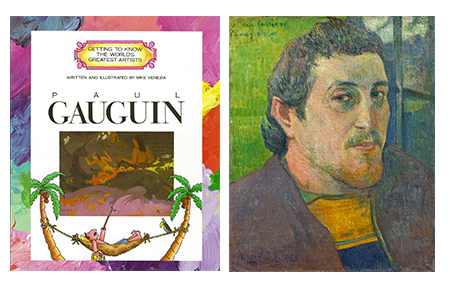
Museum Reads: Intimate Impressionism (Kids Edition)
Who says art isn’t kid-friendly? Bring your kiddos to see Intimate Impressionism from the National Gallery of Art (closing January 4!) and check out one of these children’s books on the shelves in our “Lasting Impressions” activity area. All of the books correspond to an artist or work of art in the exhibition and our permanent collection. You can also buy a copy to take home with you from the Museum Store or pop-up shop at the end of the exhibition.
Cézanne and the Apple Boy by Laurence Anholt

Paul Cézanne, Still Life with Milk Jug and Fruit, ca. 1900. Oil on canvas. National Gallery of Art, Washington, DC, Gift of the W. Averell Harriman Foundation in memory of Marie N. Harriman.
Cézanne and the Apple Boy is one of many children’s books by author and illustrator Laurence Anholt, who uses colorful imagery and a children’s perspective to help kids understand famous artists, like Paul Cézanne. This story follows Paul, Cézanne’s real life son. Paul Jr. goes to visit his father in Provence, an area where he often painted. The story details the relationship between Cézanne and his son, who was “the apple of his eye,” but also describes Cézanne’s groundbreaking painting style and rise to fame. A brief bio in the back of the book gives context to the story.
Van Gogh and the Sunflowers by Laurence Anholt

Top Right: Vincent van Gogh, Flower Beds in Holland, ca. 1883. Oil on canvas on wood. National Gallery of Art, Washington, DC, Collection of Mr. and Mrs. Paul Mellon.
Bottom Right: Vincent van Gogh. Women Crossing the Fields, 1890. Oil on paper. Collection of the McNay Art Museum, bequest of Marion Koogler McNay.
Another book by Anholt, this true story follows a young boy named Camille, whose father is a postman in the south of France. One day, a man named Vincent Van Gogh arrives and moves into a little yellow house at the end of Camille’s street. His family befriends the artist and Van Gogh paints portraits of the entire family. Actual images of the artist’s work are included in the book.
The Magical Garden of Claude Monet by Laurence Anholt
Claude Monet, Argenteuil, ca. 1872. Oil on canvas. National Gallery of Art, Washington, DC, Ailsa Mellon Bruce Collection.
The star of this book is a little girl with famous roots. In the story, and in real life, Julie Manet is the daughter of one of the few female Impressionist artists, Berthe Morisot, and the niece of Edouard Manet, another famous Impressionist. Julie, her mother, and their dog Louey visit Claude Monet at his gardens in Giverny, France. Through her exploration, Julie becomes enthralled by the magic that is the gardens and the reason for Monet’s inspiration becomes clear.
Little Ballerina by Hélène Kérillis and Lucie Albon

Edgar Degas, Dancers Backstage, 1876/1883. Oil on canvas. National Gallery of Art, Washington, DC, Ailsa Mellon Bruce Collection.
Laura, a young ballerina, travels back in time to the 19th century through a magical tutu. There, she performs alongside the ballerinas that inspired Edgar Degas many paintings and meets the younger version of her idol and famous prima ballerina, Cléo de Mérode. Mérode has lost her way when it comes to dance and Laura helps restore her confidence.
Getting to Know the World’s Greatest Artists Series: Georges Seurat by Mike Venezia

This series is much more biographical in nature, but uses fun, silly illustrations and actual works of art to explain not just ‘Who is Georges Seurat?’, but also techniques and movements, such as Pointilism and Neo-Impressionists. It also includes a discussion of methods—how he sketched and sketched and sketched before laying brush to canvas—and his most famous work, Sunday Afternoon on the Island of La Grande Jatte. Intimate Impressionism features one of Seurat’s studies he made in preparation for the work.
Getting to Know the World’s Greatest Artists Series: Paul Gauguin by Mike Venezia

Paul Gauguin, Self‑Portrait Dedicated to Carrière, 1888 or 1889. Oil on canvas. National Gallery of Art, Washington, DC, Collection of Mr. and Mrs. Paul Mellon.
Another book from Venezia’s series, this one highlights the career of Paul Gaguin, his love of symbolism and of the South Pacific. He does well to explain a complicated person in a simple and understandable way. Colorful illustrations and works of art add to the visual appeal.









